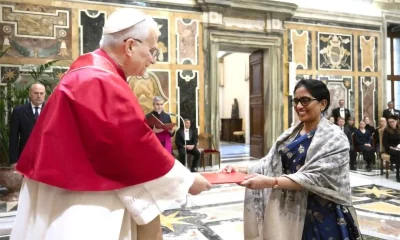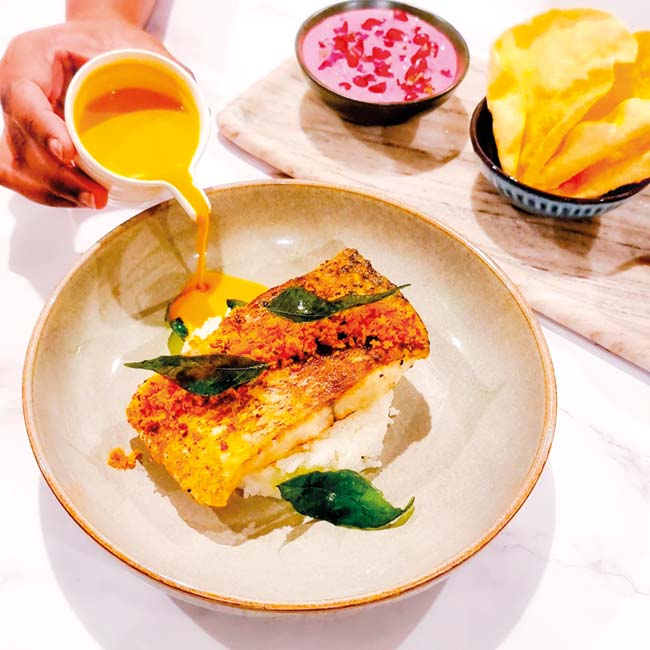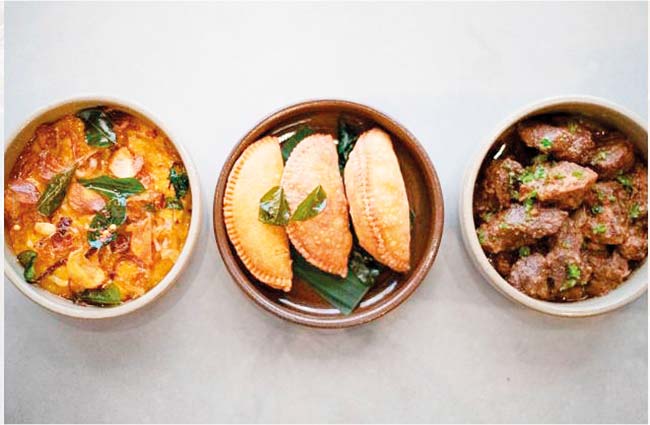Life style
Little island , big flavours : Sri Lankan food finally gets its due

By Zinara Rathnayake
When Kolamba first opened in 2019, many diners who walked into the charming eatery in central London’s Soho district weren’t familiar with Sri Lankan cuisine. They thought it was just like Indian food, says the restaurant’s co-founder, Aushi Meewella, who grew up in Sri Lanka.
“We felt Sri Lankan food was underrepresented in central London, so we wanted to bring the dishes we grew up on and missed when we moved away,” she tells CNN.
While Sri Lanka is India’s little neighbour, with only 22 million people, its food and culture are quite different.
And now, a new generation of Sri Lankan chefs and entrepreneurs across the world is shining the spotlight on their native cuisine, while embracing the country’s diverse culinary heritage.
Meewella credits tourism for the recent surge in interest and support for Sri Lankan food.
Although tourist arrivals were halted by a series of setbacks including a deadly Easter bomb attack, the Covid-19 pandemic, and, more recently, the country’s worst-ever economic crisis, Sri Lanka is back on the tourism radar, already tracking over 800,000 visitors in 2023 as of the first week of August. As Meewella explains it: “People visit, discover our diverse island, and try our food, which they realize is also delicious.”
Chef Dhayanie Williams, a contestant on “MasterChef Australia 2019,” says the rise of social media in the last decade and programs like Masterchef have also helped professional and home chefs promote Sri Lankan food in the international market.
“We’ve seen many participants stick to their roots and create authentic Sri Lankan dishes on these programs,” says the chef, who is known for the Sri Lankan crab curry and chicken curry she cooked on the show.
“This continuous online exposure makes people try out Sri Lankan food in restaurants.”
Diverse influences
Today, more and more Sri Lankan chefs across the world are championing Sri Lankan food while defying common misconceptions about the cuisine.
“It has helped change the global perception that Sri Lankan food is different from Indian food, and it’s not only a lot of curries paired with rice,” Williams says.
For example, despite sharing a name, Sri Lankan roti are smaller, thicker “discs” made of freshly grated coconut and rice flour, unlike the large Indian rotis, which are made of wheat.
Rice, coconut milk, native fruits, vegetables and seafood act as the building blocks of Sri Lankan cuisine. Meewella explains that it draws inspiration from diverse ethnic cultures and the influences of the Dutch and Portuguese, who once ruled Sri Lanka.
At Kolamba, mains include mutton poriyal, a common preparation in the Tamil-populated northern region of Sri Lanka in which the meat is dry-fried with onions, green chili and lime. One popular dessert is watalappam, a coconut and palm jaggery custard prepared by Muslims to celebrate Eid.
Meewella points out that Sri Lankan cuisine is also heavily plant-based with many vegan options, which helps the cuisine stand out and resonate with global audiences. “This way of eating is not a fad for us,” she adds.
For centuries, Sri Lankans have made use of wild and organically-grown ingredients like jackfruit, water spinach and yams, blending them with spices and herbs, and frying and currying them to create dishes with unique flavors. Kolamba’s menu pays homage to these plant-based recipes with dishes like breadfruit curry cooked with coconut milk and raw green banana fried with grated coconut.
In Sri Lankan cooking, the white flesh of the coconut is grated and squeezed to prepare rich, creamy coconut milk, which thickens different vegetable and meat-based curries. Fresh coconut milk is also added to a morning smoothie-like drink called kola kenda, made with herbs and rice. During celebratory events like the New Year or the first day of a job, Sri Lankans also cook coconut milk with rice to prepare a creamy breakfast called kiribath.
“When I hosted brunches at home, I didn’t expect there would be an appetite for dishes like kiribath, but people fell in love with the flavours of my childhood,” says Sam Fore, a Sri Lankan-American chef based in Lexington, Kentucky. “Eventually, the demand got so great that I set up a tent behind a bar in town to start selling the food I was cooking.”
Within two years, Fore’s pop-up got nationwide attention for spotlighting simple recipes incorporating Sri Lankan elements. Now, Fore is ready to open her first restaurant in Lexington.
Spicy, sour, sweet
Although people assume that Sri Lankan food is spicy, it’s made up of many other spices and herbs besides chilli. Coriander seeds, black pepper, mustard seeds, nutmeg, cinnamon, cardamom, curry leaves, pandan leaves and lemongrass are all used to flavour and scent dishes.
Spices are also roasted and ground together to make different types of curry powder, an essential flavouring agent.
These varied flavours of Sri Lankan cuisine apply well to common culinary techniques, Fore says.
For instance, she prepares fried chicken, a dish Americans are familiar with, but infuses it with the spices of Sri Lankan chicken curry, grinding and combining them with buttermilk to carry the flavours.
“I don’t dump the spices down in my dishes,” Fore says. “I try to honour the recipes passed down to me and introduce flavours to diners that appear unexpectedly, but in a way that makes them understand my point of view.”
Across the world, chefs like Fore aren’t shying away from using innovative approaches to introduce Sri Lankan cuisine.
At Nadodi, a Kuala Lumpur restaurant that serves elevated Sri Lankan and South Indian fare, Williams came across a dish called “Yesterday.” This dish was reminiscent of Sri Lankan diya bath or pazhaya soru kanji, a day-old rice soaked overnight in water and eaten with dried, cured chilies.
Nadodi serves it with fried dry fish and pickles, all layered in a mini clay pot. “The dish is authentic and awakens one’s memories through elevating flavours, and plating it in a sophisticated way,” Williams says.
In Zagreb, Croatia, Brian Senaratne, co-founder of the city’s popular Sri Lankan restaurant Curry Bowl, shares similar values.
“We preserve original flavours, but keep it simple,” he says. “Usually, when we (Sri Lankans) go to a restaurant, we order several curries and rice separately, and share it with the entire group, but we noticed that European diners each order a dish. So having 10-15 curry dishes on the menu will only make it very complicated.”
Instead, Senaratne simplified this decision-making process for his diners, most of whom are European and haven’t previously had Sri Lankan food, by introducing curry-based bowls that also look appealing.
The theatre of making some dishes also helps them stand out. Curry Bowl’s top seller is kotthu, a popular street food made by smashing roti with vegetables, eggs and meat on a metal grid with metal clamps, leading to a distinctive metal-on-metal sound.
“This was quite a show for the first-comers,” says Senaratne. “They hear the noise, come inside, and are completely amazed. We’ve had many people who try kotthu, hear about Sri Lanka from us and end up visiting Sri Lanka.”
As chefs and entrepreneurs across the world add their unique touches to native dishes, both Fore and Williams believe that interest in Sri Lankan food will continue to expand.
“As the cuisine grows, it’s going to take some creative applications of flavours like chili, lime and tamarind for a full crossover into the international palate,” Fore says. “It’s up to us as cooks to honour our roots while innovating for the future. I cannot wait for casual Sri Lankan food to become a nationwide craving across America.”
(BBC)
Life style
Aslam Hussein’s Couture and Trousseau

 At Colombo Fashion Week,held recently at Cinnamon Grand,designer Aslam Hussein delivered a collection that spoke the language of quiet confidence and refined glamour, positioning him firmly as a Fashion Edit, favourite this season.
At Colombo Fashion Week,held recently at Cinnamon Grand,designer Aslam Hussein delivered a collection that spoke the language of quiet confidence and refined glamour, positioning him firmly as a Fashion Edit, favourite this season.
‘His collection unfolded like a carefully composed symphony – each piece moving with a rhythm of elegance and poise. Aslam Hussein’s runaway was more than a presentation – it was a story of refined luxury, individuality and timeless beauty where couture met emotion and each garment became a living expression of artistry.
Colombo Fashion Week was held this November at Cinnamon Grand ,namely Couture + Trousseau . The event was part of the luxury edit focused on high fashion,bridal wear and destination wedding,celebrating CFW’’s 22 rd anniversary Aslam Hussein opened the runway and his collection balanced sharp tailoring with fluid silhouettes, creating looks that felt both modern and enduring. Clean lines, thoughtful construction and an understated palette allowed craftsmanship to take centre stage. The colour palette was muted yet rich, allowing texture and craftsmanship to speak. Luxurious fabrics caught the light with every step, revealing subtle interplay between movement and form. Each silhouette told a story of – timeless, modern and effortless elegance
Fluid silhouettes, muted palettes and clean tailoring defined his collection.
On the ramp,models moved with understated confidence, their hairstyles were created by. Ramani Fernando salons,the soft luminous makeup complemented the collection’s quiet sophistication. Each silhouette reflected Aslam’s commitment to craftsmanship, versatility and timeless style. Since establishing his label, he has been a staple on Sri Lanka’s fashion calendar, consistently presenting at Colombo Fashion Weeks and earning recognition for his designs.
His collection this year re-affirmed his mastery of understated elegance and contemporary luxury. Neutral tones were punctioned with occasion, deep shades, allowing fabric, cut and texture to take centre stage. Models carried the collection with measured poise. Make up was luminous yet natural, letting the silhouettes and individual model presence shine. Through his designs, Aslam Huseein has cultivated a following among modern cosmopolitan clientele who appreciate understated glamour, versatility and the quiet power of elegance.
His contributions have solidified his reputation as a designer who bridges Sri Lanka’s rich fashion heritage with an international sensibility.
Colombo Fashion Week is Sri Lanka’s premier event, showcasing the country’s top designers alongside emerging talent and is one of the glamorous events in the fashion landscape. The visionary is Ajay Vir Singh, founder of Colombo Fashion Week, whose leadership continues to elevate Sri Lanka’s premier fashion platform to international level.
Life style
Hairstyle maestro: Niroshan at Ramani Fernando salon at Mount Lavinia

Ramani Fernando salons is a name that has taken men and women’s grooming to new heights since its inception at Mount Lavinia. The salon has made its mark on the locals and celebrities alike. Over the years, Ramani Fernando Salons has not just set a benchmark for luxury grooming services but has also redefined how men perceive self-care, hair styling, and professional grooming. This salon at Mount Lavinia under its Manager Kappitiya Godage, namely Niroshan known by clients has become a favourite destination for those who sought more than just a haircut. The salon introduces a range of services—from precision styling and beard grooming to men’s makeup for photoshoots. The manager at Mount Lavinia is Niroshan Suresh. His philosophy emphasized that grooming is not just about appearance but also about confidence and self-expression and most importantly – self-care. He says make-up and grooming are not just limited to the opposite gender!
What makes Ramani Fernando Salon at Mount stand out. It is its innovative style and technique to men and women’s grooming. This branch prides itself on using cutting-edge tools and premium products that ensure every client leaves with a polished, customized look. The salon focus is on continuous learning and staying ahead of trends has earned it the loyalty of a discerning clientele.
Working at Ramani salons, Niroshan has spent many years perfecting the craft of styling, cutting and grooming men’s and woman’s hair, blending technical skill with a keen understanding of contemporary fashion trends. With years of experience, he guides clients on hairstyles and on the selection and proper use of styling products. His presence at Ramani Fernando salon at Mount Lavinia reinforce the brand’s reputation for excellence but also highlights the vital role of a skilled male stylist in shaping men and women’s grooming culture in Sri Lanka.
In the evolving world of men’s grooming, where style isn’t just about guiding a haircut but crafting a confident identity Niroshan at Mount Lavinia represent more than just a stylist or a place to cut hair. With Niroshan at the helm, this salon has become a place where style, innovation and meticulous grooming are curated for any client who walks in.
He is part of Ramani Fernando salons creative team, and brings creativity and precision to every look reflecting the high standards of Ramani Fernando’s renowned beauty collection
Niroshan has been with Ramani Fernando for several years and he is popular among his clients for those seeking sharp, modern and personalised hairstyles. With many years of experience, he has combined technical expertise with an eye for current trends ensuring each client leaves the salon looking confident and polished, Niroshan begins with a consultation, he carefully considers face shape, hair texture and personal style before recommending a look: He tailors each style to suit individual preferences, while ensuring easy to maintenance.
Beyond haircuts and grooming, his services include beard shaping, scalp and hair treatments and guidance on styling products. He makes each client of his leave the salon not just with a haircut but walk with confidence. He enjoys seeing his clients happy and self-assured. His experience, professionalism and knowledge make him a standard stylist in Colombo’s competitive grooming scene. He is very grateful to his senior and dynamic hairdresser Kamal for his guidance and expertise and who has been instrumental in shaping his approach to styling and artistry
by Zanita Careem ✍️
Life style
The Kingsbury, Colombo, Welcomes Season of Splendour

The Kingsbury, Colombo, welcomes the festive season with a spirit of warmth, elegance and celebration. This year’s Christmas and New Year offerings have been curated to bring guests together through moments of comfort, connection and shared joy across the hotel.
Harbour Court sets the tone for the season with its Christmas Eve Dinner Buffet, Christmas Day Brunch and Christmas Dinner on 24th and 25th December, followed by the New Year’s Eve Dinner Buffet on 31st December and the New Year’s Day Lunch and Dinner Buffets on 1st January. Kings Steakbar brings festive fine dining to Colombo with its Sunday Gourmet Carvery every Sunday in December, the Christmas Gourmet Carvery on 24th and 25th December, an á la carte Christmas Dinner on Christmas Day and a Seven-course Gourmet Dinner on New Year’s Eve.
Yue Chuan offers authentic Chinese cuisine with its signature Peking Duck Experience throughout December, daily Dim Sum and a special All You Can Eat menu on 24th, 25th and 31st December. At Tenk?, guests can enjoy elegant Japanese cuisine with the daily Teppanyaki Show, festive á la carte menus on 24th and 25th December and a New Year’s Eve Tasting Menu. Ocean highlights the best of coastal cuisine with festive á la carte menus on 24th, 25th and 31st December. Bringing Sri Lankan authenticity to the season, Tavern presents an Arrack Tasting Experience throughout December.
Festive cheer continues outdoors at Honey Beach Club with live music from 19th to 23rd December, poolside Festive party packages, and the signature New Year’s Eve celebration “Dancing Into 2026,” featuring Infinity and DJ E2. At Sky Lounge, guests can enjoy elevated festivities with Corporate Celebration packages, festive set menus, seasonal cocktails and the New Year’s Eve event “Party in the Sky,” featuring The Kingdom. Seas
For those celebrating at home, The Kingsbury offers Seasonal Roasts and festive hampers, available both ready-made and customisable, while Indulgence provides five-star delivery throughout the season. Families can also enjoy special offers, with children below six dining free and children aged six to ten receiving 50% off buffet dining. Seasonal cocktails, wine menus and bottle deals are available across all outlets.
This year, The Kingsbury, Colombo, invites guests to embrace the season with kindness, hope and cherished moments. Whether dining out, gathering with loved ones or gifting thoughtfully, we are honoured to share a season of splendour with you.
-

 Midweek Review4 days ago
Midweek Review4 days agoHow massive Akuregoda defence complex was built with proceeds from sale of Galle Face land to Shangri-La
-

 News3 days ago
News3 days agoPope fires broadside: ‘The Holy See won’t be a silent bystander to the grave disparities, injustices, and fundamental human rights violations’
-

 News3 days ago
News3 days agoPakistan hands over 200 tonnes of humanitarian aid to Lanka
-

 News4 days ago
News4 days agoBurnt elephant dies after delayed rescue; activists demand arrests
-

 Editorial4 days ago
Editorial4 days agoColombo Port facing strategic neglect
-

 News2 days ago
News2 days agoArmy engineers set up new Nayaru emergency bridge
-

 Business2 days ago
Business2 days agoUnlocking Sri Lanka’s hidden wealth: A $2 billion mineral opportunity awaits
-

 News4 days ago
News4 days agoSri Lanka, Romania discuss illegal recruitment, etc.



















